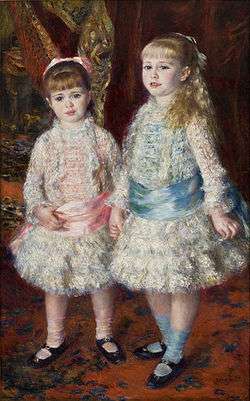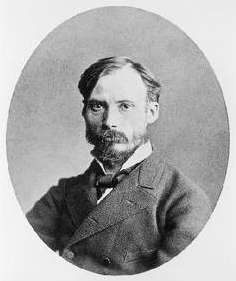Pink and Blue (Renoir)
 | |
| Artist | Pierre-Auguste Renoir |
|---|---|
| Year | 1881 |
| Medium | Oil on canvas |
| Dimensions | 119 cm × 74 cm (47 in × 29 in) |
| Location | São Paulo Museum of Art, São Paulo |
Alice and Elisabeth Cahen d’Anvers (most commonly referred to as Pink and Blue) is an oil painting by French impressionist Pierre-Auguste Renoir. Produced in Paris in 1881, the painting depicts the sisters Alice and Elisabeth, daughters of the Jewish banker Louis Raphaël Cahen d'Anvers. It is considered one of the most popular works in the collection of the São Paulo Museum of Art, where it has been conserved since 1952.
Alice and Elisabeth Cahen d’Anvers
Renoir portrayed the 2 daughters of the banker Louis Raphaël Cahen d'Anvers, the blonde, Elisabeth, born in December 1874, and the younger, Alice, in February 1876, when they were respectively six and five years old. The artist produced many portraits for the families of the Parisian Jewish community at the time, and Louis Cahen d'Anvers, married to Louise de Morpurgo, descendant of a rich family from Trieste, was one of the most wealthy.[1]
Renoir was commissioned to paint many portraits for this family, which he had met through the collector Charles Ephrussi, proprietor of the Gazette des Beaux-Arts, and the idea was to make individual portraits of each daughter. Renoir portrayed the couple's oldest daughter, Irene, in a painting nowadays conserved at the Foundation E.G. Bührle, in Zürich. Afterwards, the family decided that the other two sisters would be painted together.
According to Camesasca, there were many sitting sessions until the end of February 1881, after what Renoir went to Algiers.[2] After some decades, the youngest of the models would remember that "the boredom of the sitting sessions was recompensed by the pleasure of wearing the elegant lace dress".[3]
Alice lived until 1965 and died in Nice, aged 89. In 1895, Alice married the British Army officer Charles Vere Ferrers Townshend who led his command to its destruction at Kut al Amara in 1916. Elisabeth had a tragic destiny. After divorcing from her first husband, the diplomat and count Jean de Forceville, she married with Alfred Émile Denfert Rochereau, and got divorced from him too. In 1987, during an exhibition of São Paulo Museum of Art collection in the Fondation Pierre Gianadda in Martigny, Switzerland, Elisabeth's nephew, Jean de Monbrison, wrote a letter to the museum reporting her sad end: she was converted to Catholicism at a young age, but even so she was sent to Auschwitz due to her Jewish descent, and died on the way to concentration camp, in March 1944, aged 69.[1]
Notes
References
- Bardi, Pietro M. & Camesasca, Ettore. Museu de Arte de São Paulo Assis Chateaubriand. Catálogo – I França e Escola de Paris. São Paulo: MASP, 1979, pp. 82.
- Julian, Ph. Rose' de Renoir retrouvé. In: Le Figaro littéraire. Paris, 1962, pp. 22.
- Marques, Luiz (org). Catálogo do Museu de Arte de São Paulo Assis Chateaubriand: Arte Francesa e Escola de Paris. São Paulo: Prêmio, 1998, pp. 124–141.
